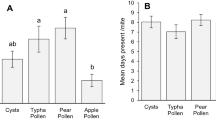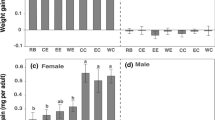Abstract
Pine oil, a by-product of the pulp industry, is a feeding repellent to snowshoe hares and voles. In pen trials with snowshoe hares and field trials with voles, when given a choice between food in a pine oil-treated bowl and a control bowl, the animals fed preferentially from the control bowl. When the hares were presented with food only in a pine oil-treated bowl, two hares showed a reduced rate of food consumption and one hare did not feed at all. Pine oil contains monoterpenes which may inhibit microbial symbionts in the digestive tracts of hares and voles. The repellent action of pine oil is likely based on this interference of digestive processes, and it is of adaptive advantage for cecal digestors to avoid it. Pine oil has potential as a commercial repellent for snowshoe hares and voles.
Similar content being viewed by others
References
Alfaro, R.I., Bordon, J.H., Harris, L. J., Nijholt, W.W., andMcMullen, L.H. 1984. Pine oil, a feeding deterrent for the white pine weevil,Pissodes strobi (Coleoptera: Curculionidae).Can. Entomol. 116:41–44.
Black, H.C.,Dimock, E.J.,Evans, J., andRochelle, J.A. 1979. Animal damage to coniferous plantations in Oregon and Washington. Part I: A survey 1963–1975. Oregon State University. For. Res. Lab., Res. Bull. 25.
Bryant, J.P. 1981. Phytochemical deterrence of snowshoe hare browsing by adventitious shoots of four Alaskan trees.Science 213:889–890.
Bryant, J.P., andKuropat, P.J. 1980. Selection of winter forage by subarctic browsing vertebrates: The role of plant chemistry.Annu. Rev. Ecol. Syst. 11:261–285.
Connolly, G.E., Ellison, B.O., Fleming, J.W., Geng, S., Kepner, R.E., Longhurst, W.M., Oh, J.H., andRussell, G.F. 1980. Deer browsing of Douglas-fir trees in relation to volatile terpene composition and in vitro fermentability.For. Sci. 26:179–193.
Dimock, E.J. 1970. Ten-year height growth of Douglas-fir damaged by hare and deer.J. For. 68:285–288.
Dimock, E.J., Silen, R.R., andAllen, V.E. 1976. Genetic resistance in Douglas-fir to damage by snowshoe hare and black-tailed deer.For. Sci. 22:106–121.
Freeland, W.J., andJanzen, D.H. 1974. Strategies in herbivory by mammals: The role of plant secondary compounds.Am. Nat. 108:269–289.
Green, J.E. 1978. Techniques for the control of small mammal damage to plants: A review. Alberta Oil Sands Environmental Research Program. Project VE 7.1.1.
Krebs, J.R. 1978. Optimal foraging: Decision rules for predators, pp. 23–63,in J.R. Krebs and N.B. Davies (eds.). Behavioural Ecology. Blackwell Scientific Publications, Oxford.
Levin, D.A. 1976. The chemical defenses of plants against pathogens and herbivores.Annu. Rev. Ecol. Syst. 7:121–159.
Nijholt, W.W. 1980. Pine oil and oleic acid delay and reduce attacks on logs by ambrosia beetles (Coleoptera: Scolytidae).Can. Entomol. 112:119–204.
Nijholt, W.W., McMullen, L.H., andSafranyik, L. 1981. Pine oil protects living trees from attack by three bark beetle species,Dendroctonus spp. (Coleoptera: Scolytidae).Can. Entomol. 113:337–340.
Oh, H.K., Sakai, T., Jones, M.B., andLonghurst, W.M. 1967. Effect of various essential oils isolated from Douglas-fir needles upon sheep and deer rumen microbial activity.Appl. Microbiol. 15:777–784.
Radwan, M.A. 1978. Foliar essential oils and deer browsing preference of Douglas-fir genotypes. U.S.D.A. For. Serv. Res. Note PNW-324.
Radwan, M.A., andEllis, W.D. 1975. Clonal variation in monoterpene hydrocarbons of vapors of Douglas-fir foliage.For. Sci. 21:63–67.
Richmond, C.E. 1985. Effectiveness of two pine oils for protecting lodgepole pine from attack by mountain pine beetle (Coleoptera: Scolytidae).Can. Entomol. 117:1445–1446.
Robbins, C.T. 1983. Wildlife Feeding and Nutrition. Academic Press, New York.
Santamour, F.S.,Cunningham, F.E., andPeterson, R.J. 1963. Variation in resistance of hard pines to mouse damage. U.S.D.A. For. Ser. Res. Note. NE-5.
Silen, R.R., andDimock, E.J. 1978. Modelling feeding preferences by hare and deer among Douglas-fir genotypes.For. Sci. 24:57–64.
Sinclair, A.R.E., Krebs, C.J., andSmith, J.N.M. 1982. Diet quality and food limitations in herbivores: the case of the snowshoe hare.Can. J. Zool. 60:889–897.
Sullivan, T.P. 1984. Effects of snowshoe hare damage on juvenile lodgepole pine-implications for spacing natural stands. B.C. Min. For. Res. Note. No. 94.
Von Althuen, F.W. 1971. Mouse damage in an 8-year old plantation.For. Chron. 47:160–161.
Author information
Authors and Affiliations
Rights and permissions
About this article
Cite this article
Bell, C.M., Rarestad, A.S. Efficacy of pine oil as repellent to wildlife. J Chem Ecol 13, 1409–1417 (1987). https://doi.org/10.1007/BF01012287
Received:
Accepted:
Issue Date:
DOI: https://doi.org/10.1007/BF01012287




